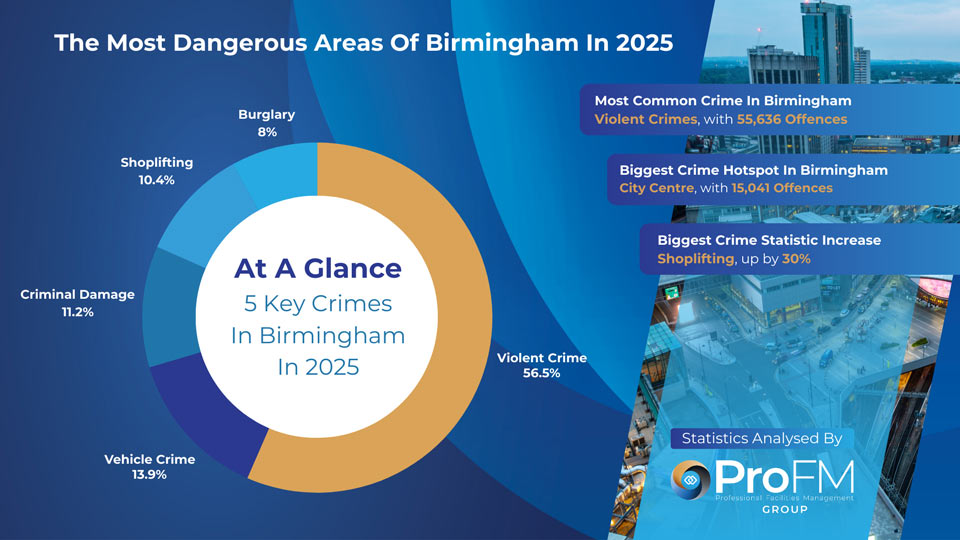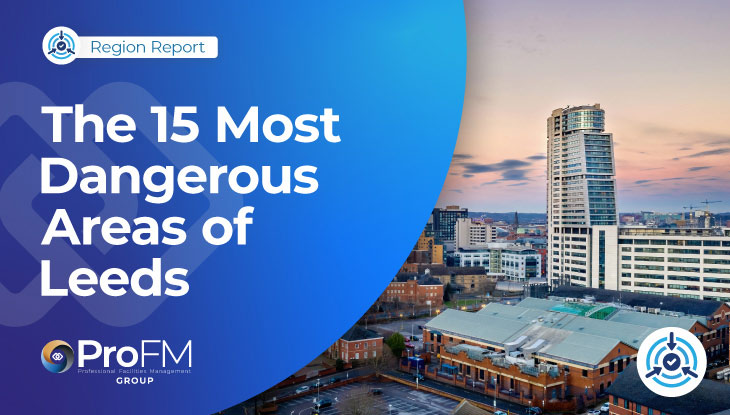The second-largest city across the whole of the UK, Birmingham has long been one of the key hubs for development and technology outside of the capital. A thriving and expansive metropolis, the city has its undoubted attractions for tourists and homeowners alike, with ranging from major entertainment venues to the world-renowned Bullring shopping centre.
However, undercutting all of those indisputable draws is the city’s consistent and worrying trend towards a soaring crime rate. Birmingham, however, is a hugely diverse city, and that rate of criminality isn’t a constant across the city.
With this article, we’ll explore the most dangerous areas of Birmingham, and the rates of crime that make them an unattractive prospect for home and business owners alike. We’ll break down the key crimes that dominate the headlines for that region, and the key points of concern for residents.
As one of the UK’s foremost security providers, we’re constantly aware of these fluctuating statistics, and how they can factor into the decision you make.
How Does ProFM Source Its Crime Statistics?
In the interests of providing a fair and objective look at crime in Birmingham, we’ve used data available from open-source West Midlands Police data, alongside independent resources, to ensure that we provide a comprehensive overview.
We’ve broken this down by wards and areas in the city, all of which are defined by Birmingham City Council. This is then displayed as a ratio of crimes per 1000 people living in the area, spread out across the latest 12 month period. We’ll do this to ensure we account for variables such as population and area size, and still ensure that we provide a complete look at each area.
What Is The Overall Crime Rate For Birmingham?

A sprawling metropolitan area at the very heart of the West Midlands, Birmingham has quite rightly been romanticised by people from all walks of life. Its consistently been one of the UK’s largest cities, and one of its most populous, with the Industrial Revolution injecting a strong sense of heritage and livelihood into the infamous Black Country.
Of course, as times have changed, so too has the city itself, becoming one of the more technologically advanced regions of the UK. Now a hub for some of the world’s most forward-thinking firms, it’s clear that Birmingham’s popularity hasn’t dwindled as we hurtle towards a changing future.
However, with that boosted popularity naturally comes a surge in crime, and this has proven to be a key sticking point for the city. In fact, in our recent piece on the most dangerous areas in the West Midlands, Birmingham ranked 3rd with a crime rate of 143.1 crimes per 1000 people.
The city’s main issues lie in its substantial rates of violent crime (76,805 incidents) and public order offences (15,439 incidents), both of which saw an increase over the figures we saw in previous years. However, these only tell a partial story.
Each area of the sprawling city area will naturally have its own issues and problems to combat in terms of crime and criminal activity. Let’s break down the most dangerous areas of Birmingham, and how their crime rate compares to the city’s overall rate.
15. Moseley & Kings Heath
Overall Crime Rate Of 170.4 Crimes Per 1000 People
Now merged under new wards, the villages of Moseley and Kings Heath are two of Birmingham’s more recognisable suburbs, largely thanks to their pivotal roles in the burgeoning arts and culture scene that dominated 1970s Birmingham. Nowadays, however, the region is plagued by a soaring crime rate of 170.4 crimes per 1000 residents.
At 19% higher than the city’s overall rate, the area’s main issues stem from high rates of violent crime (1341 incidents), vehicle crimes (552 incidents) and public order offences (318 incidents). However, data shows a distinct downward trend in the total number of offences over the last few months, hinting towards a brighter future for Mosely and Kings Heath.
14. Handsworth Wood
Overall Crime Rate Of 170.7 Crimes Per 1000 People
One of the leafier suburbs of the Birmingham area, Handsworth Wood is most recognised by its Victorian houses and affluent streets that border green spaces such as the region’s eponymous park and golf club. However, that picturesque exterior masks a less-than-ideal crime rate of 170.7 crimes per 1000 residents.
The area’s main issue lies in its substantial rate of violent crime (1540 offences), which accounts for more than 44% of the area’s total crime. High rates across theft (321 offences) and vehicle crimes (289 offences) also highlight the pressing need for security services across the city.
13. Erdington
Overall Crime Rate Of 172.1 Crimes Per 1000 People
A borough of Birmingham with an illustrious history that goes back as far as the Middle Ages, Erdington offers some of the more instantly recognisable period architecture, particular in its namesake manor. Beneath that well-maintained exterior, though, is a soaring crime rate of 172.1 crimes per 1000 residents.
Over the last year, Erdington saw some of its highest figures in violent crime (1724 incidents), which accounted for over 46% of all crime in the region. The area also saw as significant amount of public order offences (366 incidents) and vehicle crimes (290 incidents), both of which prompt security concerns.
12. Perry Barr
Overall Crime Rate Of 173.6 Crimes Per 1000 People
Situated in the shadow of the Barr Beacon, Perry Barr is one of Birmingham’s more popular suburban areas, with a well-struck balance of greenery and urban sprawl providing what first appears to be a great equilibrium for both families and businesses. However, the area’s substantial crime rate of 1773.6 crimes per 1000 residents does sully that significantly.
The main concerns for the stems from a high proportion of violent crime (1400 incidents), as well as some of the higher rates of public order offences (394 incidents) and criminal damage (300 incidents) we’ve seen so far, making up 11% and 8.5% of the region’s crime total respectively.
11. Kingstanding
Overall Crime Rate Of 175.9 Crimes Per 1000 People
A densely populated ward of Birmingham, Kingstanding is most renowned for its extensive stretches of affordable urban housing, as well as being the site of some of the first ever council-owned housing UK-wide. However, while it provides a safe haven for thousands, it’s become a crime hotspot in recent years, sitting at an alarming 175.9 crimes per 1000 residents.
Violent crime (1840 incidents), criminal damage (386 incidents), and public order offences (323 incidents) are the three leading issues for Kingstanding, although an upwards trend has seen increased concern for the overall rate of crime in the area.
10. Longbridge
Overall Crime Rate Of 179.7 Crimes Per 1000 People
One of the key feeder areas for the beating heart of Birmingham, it’s Longbridge’s exceptional public transport links that make it such an attractive option for young professionals and budding entrepreneurs alike. What’s less attractive, however, is the issues the region faces with crime, seeing a worrying rate of 179.7 crimes per 1000 residents.
The main concern arises from the substantial figures in violent crime (1755 offences), which makes up 45% of all crime in the area. However, equally concerning are the substantial numbers across criminal damage (356 offences) and theft (337 offences), both of which are above the average for the city as a whole.
9. Hodge Hill
Overall Crime Rate Of 186.8 Crimes Per 1000 People
Often characterised by its close proximity to the idyllic Kingfisher Country Park, Hodge Hill plays host to a huge range of green spaces and local attractions. Undercutting all of those irrefutable positives, however, is a highly negative crime rate of 186.8 crimes per 1000 residents.
Hodge Hill’s main issue results from the notably high rate of violent crime (1828 incidents), which makes up a substantial percentage (43.7%) of the region’s total crimes. There’s also a warranted worry for the area’s rates of shoplifting (355 incidents) and vehicle crime (339 incidents), both of which have shown an uptick in recent months.
8. Tyburn & Castle Vale
Overall Crime Rate Of 189.4 Crimes Per 1000 People
Home to the expansive Castle Vale and Pype Hayes housing estates, the ward of Tyburn is one of the larger regions of the Birmingham city area, as well as one of its more popular for both businesses and settlers. Undermining that popularity, however, is the region’s concerning crime rate of 189.4 crimes per 1000 residents.
The area’s most pressing concerns are in its high rates of violent crime (1702 offences), theft (480 offences) and vehicle crime (384 offences), all which have seen slight rises in recent months, prompting increased concern for security in the Birmingham borough.
7. Lozells & East Handsworth
Overall Crime Rate Of 196.8 Crimes Per 1000 People
A central hub for some of Birmingham’s most diverse neighbourhoods, Lozells and East Handsworth are one of the city’s largest conurbations, predominantly made up of closely compacted housing and tower blocks. While close-knit in its communities, the area’s crime rate sits at a worryingly high 196.8 crimes per 1000 residents.
Within that rate, we find significant figures across violent crime (2669 incidents, making up a sizeable 47.1% of all crime in the area), public order offences (481 incidents) and vehicle crime (450 incidents).
6. Acocks Green & Tyseley
Overall Crime Rate Of 199.1 Crimes Per 1000 People
One of the city’s more historic wards, dating back as far as the 1600s, Acocks Green and the neighbouring Tyseley have long been a huge opportunity for low-income families thanks to the extensive developments. Unfortunately though, that welcoming nature is upset substantially by the region’s soaring crime rate – 199.1 crimes per 1000 residents.
The main issues facing the area are the soaring numbers across violent crime (2118 incidents), public order offences (398 incidents) and vehicle crime (365 incidents), all of which have remained consistently high across the last year, with a rise over the figures we’d seen in 2020 and 2021.
5. Stockland Green & Gravelly Hill
Overall Crime Rate Of 214.2 Crimes Per 1000 People
A multi-faceted area of the wider Birmingham region, the ward of Stockland Green and Gravelly Hill encompasses everything from thriving industrial areas, to the notorious Spaghetti Junction at its centre. While this varied landscape provides much greater opportunity, it also opens the door for the region’s higher crime rate of 214.2 crimes per 1000 residents.
Violent crime (2382 offences) makes up over 47% of the area’s total crimes, with vehicle crimes (407 offences) and criminal damage (373 offences) making up another significant portion of the issues in Stockland Green and Gravelly Hill.
4. Edgbaston
Overall Crime Rate Of 218.1 Crimes Per 1000 People
One of Birmingham’s more affluent suburbs, it’s perhaps surprising to see Edgbaston on a list of Birmingham’s most dangerous areas. However, with significant rates across the board, the region sees a huge crime rate of 218.1 crimes per 1000 residents.
Edgbaston’s main threats stem from a disproportionately high number of violent crimes (1555 incidents), as well as a rate of vehicle crime (656 incidents) that’s significantly higher than those with a comparative population and area size.
3. Aston & Newtown
Overall Crime Rate Of 241.4 Crimes Per 1000 People
Bordered closely by our previous entry Edgbaston, the ward of Aston & Newtown is perhaps most know for its close connection to Premier League football in Aston Villa, as well as the early stages of heavy metal in the origins of Black Sabbath. However, in spite of that cultural connection, the region’s crime rate is one of the highest Birmingham-wide.
Sitting at 241.4 crimes per 1000 people over the last year, it’s a clear cause for concern for those in the area. High numbers in violent crime (2469 incidents), vehicle crime (591 incidents) and public order offences (496 incidents) all prompt concern for security in the ward.
2. Bordesley Green
Overall Crime Rate Of 290.1 Crimes Per 1000 People
One of Birmingham’s inner-city suburbs, Bordesley Green offers one of the more popular areas for those seeking to travel into the city centre. Given its balance of affordable housing and local business, the appeal of the district is apparent. What’s not immediately clear, though, is the region’s startling rate of crime – 290.1 crimes per 1000 residents.
Over the course of the last year, the area saw a huge proportion of violent crime (1875 incidents), which made up almost 50% of all crime in a relatively small area. Public order offences (332 incidents) and vehicle crimes (271 incidents) were also key causes for concern in what is the second most dangerous area of Birmingham.
1. Birmingham City Centre
Overall Crime Rate Of 349.9 Crimes Per 1000 People
Birmingham’s city centre is among the country’s sparkling attractions, offering a hubbub of nightlife, retail opportunities, and a prestigious educational experience in its university. However, beneath that undoubtedly appealing exterior lurks a truly shocking crime rate of 349.9 crimes per 1000 residents, which is more than twice the city-wide average.
As part of that rate, there are alarming statistics across violent crime (5815 offences), theft (1785 offences) and shoplifting (1776 offences), which make up more than 50% of the city centre’s total crimes, which currently sit at 16,924 offences over the course of the last year.
 Sales:
0808 196 2872
Sales:
0808 196 2872
 Support:
0344 477 9991
Support:
0344 477 9991
 Contact Us
Contact Us
 Staff & Client Login
Staff & Client Login





